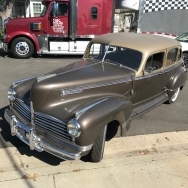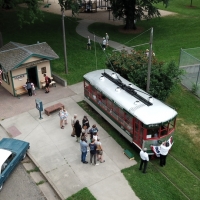42 Eight wont idle Carter WDO
The car is a 1942 eight with a Carter WDO carburetor. Old and yucky when I got it, I opened it up, soaked it and put a kit in it. Car starts easily and runs great, but it just wont idle.
It will run without problems when reved up (1000 RPM?) but anything less and it is like switching off the key. (immediately stops)
I have checked all the electrical dwell, timing, plugs, wires, etc. Fuel pump puts out 3.5 PSI
Again it restarts quickly and easily but just wont idle.
I have only had the car a few weeks and this might have been a long standing issue on this car because there is a well engineered (but home made) cable mounted on the steering column that opens the throttle linkage.
Obviously the problem is somehow with the idle circuit, since it runs fine at higher RPM.
I will be taking it apart again, but does anybody have any experience or are there things that are known to be problematic with this carb?
Thanks, Jim
It will run without problems when reved up (1000 RPM?) but anything less and it is like switching off the key. (immediately stops)
I have checked all the electrical dwell, timing, plugs, wires, etc. Fuel pump puts out 3.5 PSI
Again it restarts quickly and easily but just wont idle.
I have only had the car a few weeks and this might have been a long standing issue on this car because there is a well engineered (but home made) cable mounted on the steering column that opens the throttle linkage.
Obviously the problem is somehow with the idle circuit, since it runs fine at higher RPM.
I will be taking it apart again, but does anybody have any experience or are there things that are known to be problematic with this carb?
Thanks, Jim
0
Comments
-
Sounds like a vacuum leak. A light spray oil or carb cleaner around intake or carb base should locate it. Check hose to vacuum wiper for leak.
Is compression even?
Does it have Drivemaster accesory? , good spot for vacuum leak.
0 -
Idle screws should be open 1 1/2. then open until running smooth and open another 1/4 turn. Do a compression test. If there's an intake valve that's stuck or not closing all the way due to adjustment, that will screw up the whole intake mixture. Valves should be to spec plus .001 if adjusted cold and an additional .002 for the new gas per Walt Mordenti.0
-
My 1936T suffered the same problem last month. Figured the needle or channels were gummed. Bought a cheap carb spray and whilst running sprayed 3/4 of the can down the air inlet. It took about 15 min of revving up and done before the car started to behave normal ie idle and no lags when revving. A week later gave it another go just as prevention... Car perfect... Saved me a carb rebuild... Figured I just need to get the car on the road more as sitting around isn't kind to the engine cheers ken0
-
Vacuum is 18 inches (at as low an idle as I can get it) seems good.
No Drive-master, no perceptible leaks.
Compression is; 90, 85, 90, 100, 95, 100, 100, 85. Certainly not a newly rebuilt engine, but seems good enough.
I took the carb completely apart and soaked it and assembled it with new gaskets, needle/seat etc.
In reading and re-reading in both the Hudson manual and a Motors manual, they made some statements about the (low speed) idle jet;
1. It can only be cleaned with compressed air never a wire.
2. It must use the exact same copper gasket that was installed in the factory, and never install it without a gasket.
3. You cannot change idle jets between carbs. They are sized for that exact carb
4. You must always install a brand new idle jet and neve reuse the old one.
Wow, had to imagine that an 80 year old carburetor could be so precise!
Next evaluation is to play with the choke plate and see if the idle can be affected by making it either richer or leaner.0 -
Follow up for future reference.
The kit I used was brand new and in the trunk with a bunch of other parts when I got the car. No manufacture name but the numbers Googled back to a kit available from Summit Racing.
The gaskets were NOT exact. The Carter WDO was used by a lot of makers in the 1940s Buick, Chrysler, etc. I had to trim some of the gaskets that seemed to be universal. The instructions in the envelope said that it might be necessary.
The problem was the gasket(s) between the float bowl part and the throttle plate part. It was too thick AND the kit did not have the small circular seals that seal the 3 passages between these two parts. A vacuum leak existed and so no vacuum or fuel could pass between the two.
I purchased a carb kit from https://www.thecarburetorshop.com/ A very knowledgeable guy who really knows carbs and makes the kits himself.
It DID have the correct gaskets (for my carb) and the seals to fit between the upper and lower halves.
Lesson? Get a high quality made right kit.0 -
I’ve been having a problem like this on my 53 Hornet and something I did was took the carbs apart again and soaked them again and blew them out with compressed air(again).Something else is (on my 65 Ford) I rebuilt the carb with a new kit but the new kits needle and seat where garbage I put the old one back in and it sealed nicely . Don’t always trust a new kit most of them are made in China with little precision.Also how new is your intake manifold gasket?
best of luck
-Blake
ps something that might help your lower compression cylinders and even the whole engine is mmo (marvel mystery oil) leave it for a few days at least . (Fore warning , make sure your in a nice open area before you start it . If you do it you’ll see what I mean)0
Categories
- 36.9K All Categories
- 113 Hudson 1916 - 1929
- 20 Upcoming Events
- 92 Essex Super 6
- 28.6K HUDSON
- 574 "How To" - Skills, mechanical and other wise
- 995 Street Rods
- 151 American Motors
- 178 The Flathead Forum
- 49 Manuals, etc,.
- 78 Hudson 8
- 44 FORUM - Instructions and Tips on using the forum
- 2.8K CLASSIFIEDS
- 608 Vehicles
- 2.2K Parts & Pieces
- 77 Literature & Memorabilia
- Hudson 1916 - 1929 Yahoo Groups Archived Photos




